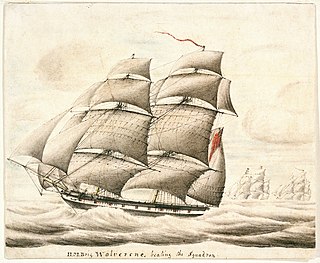Palinure-class brigs of the French navy include:
Nisus or Nisos may refer to:
Five ships of the Royal Navy have borne the name HMS Plumper:
USS Herald was a full-rigged ship of about 270 tons burthen built in 1797 at Newburyport, Massachusetts. The US Navy purchased her on 15 June 1798, and sold her in 1801. She became the French 20-gun privateer corvette Africaine. In 1804 a British privateer seized her on 4 May 1804 off the coast, near Charleston, South Carolina. The seizure gave rise to a case in the U.S. courts that defined the limits of U.S. territorial waters. The U.S. courts ruled that the privateer had seized Africaine outside U.S. jurisdiction. Africaine then became a Liverpool-based slave ship that made two voyages carrying slaves from West Africa to the West Indies. After the abolition of the slave trade in 1807 she became a West Indiaman that two French privateers captured in late 1807 or early 1808.

Uranie was a frigate of the French Navy launched in 1788. She took part in a frigate action in 1793, capturing HMS Thames, and was renamed Tartu in honour of her captain, Jean-François Tartu, who was killed in the action. The Royal Navy captured her in 1797. She served as HMS Uranie until the Royal Navy sold her in 1807.

HMS Wolverine was a Royal Navy 18-gun Cruizer-class brig-sloop, launched in 1805 at Topsham, near Exeter. Early in her career she was involved in two fratricidal incidents, one involving a British frigate and then a newsworthy case in which she helped capture a British slave ship. She later captured a small naval vessel and several privateers, and took part in the invasion of Martinique, and during the War of 1812, in the attack on Baltimore. Wolverine was decommissioned in August or September 1815 and was sold on 15 February 1816.

HMS Carnation was a Royal Navy 18-gun Cruizer-class brig-sloop built by Taylor at Bideford and launched in 1807. After the French brig Palinure captured her, she was burned by the French to prevent her recapture.
HMS Circe was a Royal Navy 32-gun fifth-rate frigate, built by Master Shipwright Joseph Tucker at Plymouth Dockyard, and launched in 1804. She served in the Caribbean during the Napoleonic Wars, and participated in an action and a campaign for which in 1847 in the Admiralty authorised the issuance of the Naval General Service Medal with clasps. The action, off the Pearl Rock, near Saint-Pierre, Martinique, was a debacle that cost Circe dearly. However, she also had some success in capturing privateers and a French brig. She was sold in 1814.

HMS Favourite was a 16-gun Cormorant-class sloop of the Royal Navy, launched in 1794 at Rotherhithe. The French captured her in 1806 and renamed her Favorite. However, the British recaptured her in 1807 and renamed her HMS Goree. She became a prison ship in 1810 and was broken up in Bermuda in 1817.

Palinure was the nameship for the Palinure-class of 16-gun brigs of the French Navy, and was launched in 1804. In French service she captured Carnation before Circe captured her in turn. After being taken into the Royal Navy as HMS Snap, she participated in two campaigns that qualified her crew for the Naval General Service Medal (NGSM). She was broken up in 1811.

HMS Scorpion was a Royal Navy Cruizer-class brig-sloop built by John King at Dover and launched in 1803. She was the first of the class to be built since the launching of Cruizer in 1797. Scorpion had a long and active career during the Napoleonic Wars, earning her crews three clasps to the Naval General Service Medal when the Admiralty authorized it in 1847, two for single-ship actions. She also took a number of prizes. Scorpion was sold in 1819.

During the eighteenth and nineteenth centuries the Royal Navy made use of a considerable number of hired armed vessels. These were generally smaller vessels, often cutters and luggers, that the Navy used for duties ranging from carrying despatches and passengers to convoy escort, particularly in British coastal waters, and reconnaissance.
There were two, and possibly three, vessels named His Majesty's hired armed brig Ann that served the British Royal Navy. The first participated in an engagement in 1807 that would earn her crew the Naval General Service Medal. She is sometimes referred to in sources as the hired armed cutter Ann or the hired armed brig Anne. Little or nothing is known of the second and third hired armed brigs Ann or Anne.
The French brig Phaeton was a Palinure-class brig launched in 1804. The British captured her in 1806 and renamed her HMS Mignonne. In 1807 they renamed her HMS Musette. She was sold in 1814.

The French brig Voltigeur was a Palinure-class brig launched in 1804. The British captured her in 1806 and renamed her HMS Pelican. She was sold in 1812.
The French lugger Affronteur was launched in 1795 and in 1796-7 participated in the Expédition d'Irlande. In 1803, HMS Doris captured her and she subsequently served the Royal Navy either as a commissioned vessel or, more probably, as His Majesty's hired armed brig Caroline. In 1807 she was either broken up, or became a letter of marque.
The French brig Pandour was a brig of the French Navy launched in 1804 that the Royal Navy captured in 1806. In 1807 she became a whaler in the South Seas Fisheries, but was lost in late 1809.
HMS Pert was the French privateer Bonaparte, a ship built in the United States that HMS Cyane captured in November 1804. The Royal Navy took Bonaparte into service as HMS Pert. Pert was wrecked off the coast of what is now Venezuela in October 1807.
Palinure may refer to: